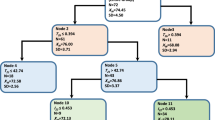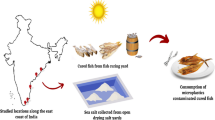Abstract
For many studies, it is important to measure the total lipid content of biological samples accurately. The Bligh and Dyer method of extraction was developed as a rapid but effective method for determining total lipid content in fish muscle. However, it is also widely used in studies measuring total lipid content of whole fish and other tissues. Although some investigators may have used modified Bligh and Dyer procedures, rarely have modifications been specified nor has their effectiveness been quantitatively evaluated. Thus, we compared this method with that of the classic. Folch extraction in determining total lipid content of fish samples ranging from 0.5 to 26.6% lipid. We performed both methods as originally specified, i.e., using the chloroform/methanol/water ratios of 1∶2∶0.8 and 2∶2∶1.8 (before and after dilution, respectively) for Bligh and Dyer and of 8∶4∶3 for Folch, and with the initial solvent/sample ratios of (3+1)∶1 (Bligh and Dyer) and 20∶1 (Folch). We also compared these with several other solvent/sample ratios. In samples containing <2% lipid, the results of the two methods did not differ. However, for samples containing <2% lipid, the Bligh and Dyer method produced significantly lower estimates of lipid content, and this underestimation increased significantly with increasing lipid content of the sample. In the highest lipid samples, lipid content was underestimated by up to 50% using the Bligh and Dyer method. However, we found a highly significant linear relationship between the two methods, which will permit the correction of reported lipid levels in samples previously analyzed using an unmodified Bligh and Dyer extraction. In the future, modifications to procedures and solvent/sample ratios should be described.
Similar content being viewed by others
References
Christic, W.W. (1982) Lipid Analysis, 2nd edn., Pergamon Press, New York.
Folch, J., Lees, M., and Sloane-Stanley, G.H. (1957) A Simple Method for the Isolation and Purification of Total Lipides from Animal Tissues, J. Biol. Chem. 226, 497–509.
Bligh, E.G., and Dyer, W.J. (1959) A Rapid Method of Total Lipid Extraction and Purification, Can. J. Biochem. Physiol. 37, 911–917.
Bailey, S.K., and Wells, D.E. (1994) The Measurement of Lipids as a Co-factor for Organic Contaminants in Biota, in Proceedings of the QUASIMEME Lipid Workshop, Dublin.
Smedes, F., and Askland, T.K. (1999) Revisiting the Development of the Bligh and Dyer Total Lipid Determination Method, Mar. Pollut. Bull. 38, 193–201.
Ackman, R.G. (1980) Fish Lipids, Part 1, in Advances in Fish Science and Technology (Connell, J.J., ed.), pp. 86–103, Fishing News Books, Surrey, England.
Linko, R.R., Kaitaranta, J.K., and Vuorela, R. (1985) Comparison of the Fatty Acids in Baltic Herring and Available Plankton Feed, Comp. Biochem. Physiol. 82B, 699–705.
Sargent, J.R., Parkes, R.J., Mueller-Harvey, I., and Henderson, R.J. (1988) Lipid Biomarkers in Marine Ecology, in Microbes in the Sea (Sleigh, M.A., ed.), pp. 119–138, Ellis Horwood, Chichester, United Kingdom.
Roose, P., and Smedes, F. (1996) Evaluation of the Results of the QUASIMEME Lipid Intercomparison: The Bligh and Dyer Total Lipid Extraction Method, Mar. Pollut. Bull. 32, 674–680.
Iverson, S.J., Frost, K.J., and Lowry, L.F. (1997) Fatty Acid Signatures Reveal Fine Scale Structure of Foraging Distribution of Harbor Seals and Their Prey in Prince William Sound, Alaska, Mar. Ecol. Prog. Ser. 151, 255–271.
Montgomery, W.L., Umino, T., Nakagawa, H., Vaughn, I., and Shibuno, T. (1999) Lipid Storage and Composition in Tropical Surgeonfishes (Teleostei: Acanthuridae), Mar. Biol. 133, 137–144.
Payne, S.A., Johnson, B.A., and Otto, R.S. (1999) Proximate Composition of Some North-Eastern Pacific Forage Fish Species, Fisheries Oceanogr. 8, 159–177.
Wamberg, S., Olesen, C.R., and Hansen, H.O. (1992) Influence of Dietary Sources of Fat on Lipid Synthesis in Mink (Mustela vison) Mammary Tissue, Comp. Biochem. Physiol. 103A, 199–204.
Arnould, J.P.Y., Boyd, I.L., and Clarke, A. (1995) A Simplified Method for Determining the Gross Chemical Composition of Pinniped Milk Samples, Can. J. Zool. 73, 404–410.
Undeland, I., Harrod, M., and Lingnert, H. (1998) Comparison Between Methods Using Low-Toxicity Solvents for the Extraction of Lipids from Herring (Clupea harengus), Food Chem. 61, 355–365.
Smedes, F., and Thomasen, T.K. (1996) Evaluation of the Bligh and Dyer Lipid Determination Method, Mar. Pollut. Bull. 32, 681–688.
Iverson, S.J., Sampugna, J., and Oftedal, O.T. (1992) Positional Specificity of Gastric Hydrolysis of Long-Chain n−3 Polyunsaturated Fatty Acids of Seal Milk Triglycerides, Lipids 27, 870–878.
Author information
Authors and Affiliations
Corresponding author
About this article
Cite this article
Iverson, S.J., Lang, S.L.C. & Cooper, M.H. Comparison of the bligh and dyer and folch methods for total lipid determination in a broad range of marine tissue. Lipids 36, 1283–1287 (2001). https://doi.org/10.1007/s11745-001-0843-0
Received:
Revised:
Accepted:
Issue Date:
DOI: https://doi.org/10.1007/s11745-001-0843-0




